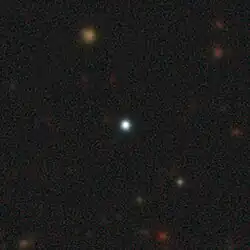SDSS J143317.78+101123.3
| Observation data Epoch J2000 Equinox | |
|---|---|
| Constellation | Boötes[1] |
| Right ascension | 14h 33m 17.7877s[2] |
| Declination | +10° 11′ 23.485″[2] |
| Apparent magnitude (V) | 18.86[3] |
| Characteristics | |
| J1433 | |
| Evolutionary stage | White dwarf |
| Spectral type | WD |
| J1433b | |
| Evolutionary stage | Brown dwarf |
| Spectral type | L1±1 |
| Astrometry | |
| Proper motion (μ) | RA: −12.782[2] mas/yr Dec.: −53.117[2] mas/yr |
| Parallax (π) | 4.2866±0.1566 mas[2] |
| Distance | 760 ± 30 ly (233 ± 9 pc) |
| Absolute bolometric magnitude (Mbol) | 25 |
| Orbit[4] | |
| Period (P) | 78.1 min |
| Semi-major axis (a) | 0.5869 R☉ |
| Inclination (i) | 84.36° |
| Semi-amplitude (K1) (primary) | 33.8 km/s |
| Semi-amplitude (K2) (secondary) | 511.1 km/s |
| Details | |
| J1433 | |
| Surface gravity (log g) | 8.41[4] cgs |
| Temperature | 13,200±200[5] K |
| J1433b | |
| Mass | 0.055±0.008[5] M☉ |
| Mass | 58±8[5] MJup |
| Temperature | 2,401±10 K (day) 2,344±7 (night)[5] K |
| Other designations | |
| J1433, PM J14332+1011, SDSS J143317.78+101122.8, Gaia EDR3 1176468611268115200, Gaia DR2 1176468611268115200 | |
| J1433b: SDSS J143317.78+101122.8b | |
| Database references | |
| SIMBAD | data |
SDSS J143317.78+101123.3 (shortened to SDSS J1433+1011, more simply J1433) is a binary system composed of a white dwarf and a brown dwarf. The brown dwarf is about 57 Jupiter masses and has transitioned from a stellar object to a brown dwarf due to losing mass to the white dwarf. As of 2016, this was the only known binary of this type.[5]
References
- ^ Roman, Nancy G. (1987). "Identification of a constellation from a position". Publications of the Astronomical Society of the Pacific. 99 (617): 695. Bibcode:1987PASP...99..695R. doi:10.1086/132034. Constellation record for this object at VizieR.
- ^ a b c d e Vallenari, A.; et al. (Gaia collaboration) (2023). "Gaia Data Release 3. Summary of the content and survey properties". Astronomy and Astrophysics. 674: A1. arXiv:2208.00211. Bibcode:2023A&A...674A...1G. doi:10.1051/0004-6361/202243940. S2CID 244398875. Gaia DR3 record for this source at VizieR.
- ^ Skinner, Julie N.; Thorstensen, John R.; Lépine, Sébastien (2014). "Cataclysmic Variables in the Superblink Proper Motion Survey". The Astronomical Journal. 148 (6): 115. arXiv:1409.1921. Bibcode:2014AJ....148..115S. doi:10.1088/0004-6256/148/6/115.
- ^ a b Savoury, C. D. J.; Littlefair, S. P.; Dhillon, V. S.; Marsh, T. R.; Gänsicke, B. T.; Copperwheat, C. M.; Kerry, P.; Hickman, R. D. G.; Parsons, S. G. (2011). "Cataclysmic variables below the period gap: Mass determinations of 14 eclipsing systems". Monthly Notices of the Royal Astronomical Society. 415 (3): 2025. arXiv:1103.2713. Bibcode:2011MNRAS.415.2025S. doi:10.1111/j.1365-2966.2011.18707.x. S2CID 119180368.
- ^ a b c d e Hernández Santisteban, Juan V.; Knigge, Christian; Littlefair, Stuart P.; Breton, Rene P.; Dhillon, Vikram S.; Gänsicke, Boris T.; Marsh, Thomas R.; Pretorius, Magaretha L.; Southworth, John; Hauschildt, Peter H. (2016). "An irradiated brown-dwarf companion to an accreting white dwarf". Nature. 533 (7603): 366–368. arXiv:1605.07132. Bibcode:2016Natur.533..366H. doi:10.1038/nature17952. PMID 27193683. S2CID 4448224.
External links
- Stellar cannibalism transforms star into brown dwarf University of Southampton
